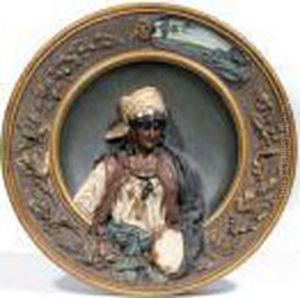Johann Maresch Paintings
Johann Maresch was a Bohemian industrialist and entrepreneur primarily known for his contributions to the ceramics industry during the 19th century. Born in 1821 in what is now the Czech Republic, Maresch started his career in the ceramics field at a young age. His work was not that of a traditional artist; rather, he was an innovator and businessman who left a significant mark on the production and design of ceramics.
Maresch established the Johann Maresch Terracotta Factory in Aussig, a town on the Elbe River in northern Bohemia, which was part of the Austro-Hungarian Empire at that time. His factory became noted for producing a wide range of terracotta products, including decorative figurines, architectural elements, and functional household items. The designs often reflected the popular styles of the time, such as Historicism and Art Nouveau, and Maresch's company thrived by catering to the tastes of the European middle class.
The success of his enterprise was partly due to his ability to blend artistic sensibilities with the demands of mass production. While Maresch himself was not a renowned artist, he employed skilled craftsmen and designers who created original molds and sculptures for the factory's products. These designs often featured naturalistic themes and were sometimes whimsical or fantastical in nature. The pieces produced in his factory were marked with a distinctive 'JM' monogram, which has become a valuable identifier for collectors today.
Johann Maresch's contributions to the field of ceramics are best understood within the context of the Industrial Revolution's impact on art and design. He was part of a broader movement that saw the democratization of art through industrial means, allowing more people to access beautiful objects for their homes. Maresch's work is not as widely known as that of some contemporary ceramicists, but his factory's output represents a significant chapter in the history of European decorative arts.
Johann Maresch passed away in 1914. His factory continued to operate after his death, but the changing political and economic landscape of Europe, particularly after World War I, led to shifts in the company's fortunes. Today, pieces from the Johann Maresch Terracotta Factory are sought after by collectors and serve as a testament to the industrious spirit and aesthetic contributions of their era.
